Chapter 23.62
SIGNS ON PRIVATE PROPERTY
Sections:
23.62.010 Purpose and applicability.
23.62.040 Review and approval.
23.62.050 Basic policies for sign regulation.
23.62.070 Permits and entitlements for signs.
23.62.110 Standards for special category signs.
23.62.120 General development, maintenance, and removal.
23.62.130 Permitted signs by type and development characteristics.
23.62.140 Temporary and special event signs.
23.62.150 Signs on residential uses.
23.62.160 Nonconforming signs.
23.62.180 Relocated billboards.
23.62.010 Purpose and applicability.
This chapter establishes the regulation of signs within the regulatory scope of this chapter as a way to:
A. Encourage creative and innovative approaches to signage within the community that are of a quality design and character and do not detract from the overall appearance of the community; and
B. Encourage signs that are architecturally and cosmetically compatible with the surrounding area; and
C. Enhance the overall property values in the City by discouraging signs which contribute to the visual clutter of the streetscape, such as oversized signs and excessive temporary signs; and
D. Enhance aesthetic and traffic safety in the community to ensure that signage does not distract motorists, obstruct, or otherwise impede traffic circulation; and
E. Safeguard and protect the public health, safety, and welfare through appropriate prohibitions, regulations, and controls on the design, location, and maintenance of signs.
The standards of this chapter apply to signs in all zoning districts. Only the signs authorized by this chapter shall be allowed. [Ord. 26-2006 §3, eff. 8-11-2006]
23.62.020 Regulatory scope.
This chapter regulates signs, as defined herein, when they are on private property or otherwise not within the scope of EGMC Chapter 23.61, Private Party Signs on City Property, the Elk Grove Municipal Code chapter addressing parades, demonstrations, protests, and special events, or the Elk Grove Municipal Code chapter addressing conduct at City Council and Planning Commission meetings. [Ord. 28-2007 §3, eff. 10-26-2007; Ord. 26-2006 §3, eff. 8-11-2006]
23.62.030 Authority.
This chapter is adopted pursuant to Sections 65000 et seq., 65850(b), 38774, and 38775 of the California Government Code, Sections 5200 and 5490 et seq. of the Business and Professions Code, Section 713 of the Civil Code, Section 556.1 of the Penal Code, and other applicable State laws. [Ord. 28-2007 §3, eff. 10-26-2007; Ord. 26-2006 §3, eff. 8-11-2006]
23.62.040 Review and approval.
All decisions, approvals, orders and appeals regarding signs within the regulatory scope of this chapter, including but not limited to decisions on sign permits, shall be made pursuant to the procedures stated in this chapter. [Ord. 26-2006 §3, eff. 8-11-2006]
23.62.050 Basic policies for sign regulation.
A. Enforcement. The Development Services Director is authorized and directed to enforce and administer the provisions of this chapter.
B. Regulatory Interpretations. All regulatory and administrative interpretations of this chapter are to be exercised in light of the City’s message neutrality and message substitution policies. Where a particular type of sign is proposed in a permit application, and the type is neither expressly allowed nor prohibited by this chapter, or whenever a sign does not qualify as a “structure” as defined in this title or the building code, then the Development Services Director shall approve, conditionally approve or disapprove the application based on the most similar sign type that is expressly regulated by this chapter, in light of the policies stated in this chapter.
C. Message Neutrality. It is the City’s policy and intent to regulate signs in a content-neutral manner as to noncommercial messages and viewpoint-neutral or content-neutral as to commercial message.
D. Message Substitution. Subject to the property owner’s consent, a noncommercial message of any type may be substituted in whole or in part for the message displayed on any sign for which the sign structure or mounting device is legal without consideration of message content. Such substitution of message may be made without any additional approval or permitting. The purpose of this provision is to prevent any inadvertent favoring of commercial speech over noncommercial speech, or favoring of any particular noncommercial message over any other noncommercial message. In addition, any on-site commercial message may be substituted, in whole or in part, for any other on-site commercial message; provided, that the sign structure or mounting device is legal without consideration of message content. This provision does not create a right to increase the total amount of signage on a parcel, lot or land use; does not affect the requirement that a sign structure or mounting device be properly permitted; does not allow a change in the physical structure of a sign or its mounting device; and does not allow the substitution of an off-site commercial message in place of an on-site commercial message or a noncommercial message.
E. On-Site/Off-Site Distinction. Within this chapter, the distinction between on-site (or on-premises or point-of-sale) and off-site (or off-premises or non-point-of-sale) applies only to commercial speech messages.
F. Billboard Policy. Except as provided in EGMC Section 23.42.080 (Business center district sign overlay zone (BCS)), new billboards, as defined herein, are prohibited. Except as provided in EGMC Section 23.42.080, the City completely prohibits the construction, erection or use of any billboard, other than those which legally exist in the City, or which has been approved by the City Council, or for which a valid permit has been issued and has not expired, as of the date on which this provision is first adopted. No permit shall be issued for any billboard which violates this policy, and the City will take immediate enforcement or abatement action against any billboard constructed or maintained in violation of this policy. In adopting this provision, the City Council affirmatively declares that it would have adopted this billboard policy even if it were the only provision in this division. The City Council intends for this billboard policy to be severable and separately enforceable even if other provision(s) of this division may be declared, by a court of competent jurisdiction, to be unconstitutional, invalid or unenforceable. Notwithstanding the preceding prohibition, nothing in this chapter prohibits the relocation of existing billboards pursuant to EGMC Section 23.62.180.
G. Noncommunicative Aspects. All rules and regulations concerning the noncommunicative aspects of signs, such as location, size, height, illumination, spacing, orientation, etc., stand enforceable independently of any permit or approval process.
H. Discretionary Approvals. Whenever any sign permit, variance, CUP, uniform sign program or special planning area approval, or other sign-related decision is made by any exercise of official discretion, such discretion shall be exercised only as to the noncommunicative aspects of the sign, such as size, height, orientation, location, setback, illumination, spacing, scale and mass of the structure, etc. Graphic design may be evaluated only for a Uniform Sign Program, and then only as applicable to commercial message signs.
I. Mixed-Use Zones or Overlay Districts. In any zone where both residential and nonresidential uses are allowed, the sign-related rights and responsibilities applicable to any particular parcel or land use shall be determined as follows: residential uses shall be treated as if they were located in a zone where a use of that type would be allowed as a matter of right, and nonresidential uses shall be treated as if they were located in a zone where that particular use would be allowed, either as a matter of right or subject to a conditional use permit or similar discretionary process.
J. Legal Nature of Sign Rights. As to all signs attached to real property, the signage rights, duties and obligations arising from this chapter attach to and travel with the land or other property on which a sign is mounted or displayed. This provision does not modify or affect the law of fixtures, sign-related provisions in private leases regarding signs (so long as they are not in conflict with this chapter or other law), or the ownership of sign structures. This provision does not apply to handheld signs or other images which are aspects of personal appearance.
K. Owner’s Consent. No sign may be placed on private property without the consent of the property owner or persons holding the present right of possession and control.
L. Prospective Regulation. This chapter applies only to signs whose structure or housing has not been permanently affixed to its intended premises on the date on which the ordinance or regulation is adopted. This chapter does not affect signs which were legally installed and which exist as of the date this chapter first takes effect.
M. Severance. If any section, sentence, clause, phrase, word, portion or provision of this chapter is held invalid, unconstitutional, or unenforceable, by any court of competent jurisdiction, such holding shall not affect, impair, or invalidate any other section, sentence, clause, phrase, word, portion, or provision of this chapter which can be given effect without the invalid portion. In adopting this chapter, the City Council affirmatively declares that it would have approved and adopted this chapter even without any portion which may be held invalid or unenforceable. [Ord. 1-2023 §3 (Exh. A), eff. 3-10-2023; Ord. 24-2015 §11 (Exh. I), eff. 2-12-2016; Ord. 13-2013 §5, eff. 10-25-2013; Ord. 12-2012 §10(B), eff. 7-27-2012; Ord. 8-2011 §29(A), eff. 6-24-2011; Ord. 26-2006 §3, eff. 8-11-2006]
23.62.060 Definitions.
Terms unique to this chapter are listed in EGMC Chapter 23.100 (General Definitions). [Ord. 8-2011 §29(B), eff. 6-24-2011]
23.62.070 Permits and entitlements for signs.
The following permits or entitlements shall be required for signs.
A. Sign Permit Required. A sign permit shall be required for all permanent signs (building attached or freestanding) prior to erection, relocation, alteration, or replacement of a sign, unless otherwise exempted by this chapter. The process for application, review, and decision regarding a sign permit shall be as established in EGMC Section 23.16.020, Zoning clearance/plan check. A sign permit shall not be required for general maintenance of existing signs or the replacement of the sign face (including message) when the area of the sign is not being changed and a building permit is not required (e.g., the replacement of a sign face on a can sign). A sign permit is also not required for the establishment of temporary signs; however, such signs shall be consistent with the development standards and time duration limits established in this chapter.
B. Sign Program Required. In order to provide for the integration of project signage and ensure compatibility with the architecture of related buildings, a uniform sign program (either major or minor) shall be required for all new multi-tenant shopping centers, office parks, and other multi-tenant, mixed-use, or otherwise integrated developments of three (3) or more separate tenants/uses that share buildings, public spaces, landscape, and/or parking facilities. There are two (2) types of uniform sign programs: major and minor. Both programs provide a process for the City’s review of and decisions related to requests for signs for multi-tenant projects. The intent of the uniform sign programs is to allow for the integration of a project’s signs with the design of the structures involved to achieve a unified architectural statement and to approve common sign regulations for multi-tenant projects. The process for application, review, and decision of uniform sign programs is described in EGMC Section 23.16.027, Uniform sign program. This section also describes the allowed deviations and the standards for approval of a major uniform sign program.
The differences between the programs are as follows:
1. Minor Uniform Sign Program. A minor uniform sign program does not allow for deviations from the signage standards in this title.
2. Major Uniform Sign Program. The intent of the major uniform sign program is to:
a. Provide a process for the application of sign regulations in ways that will allow creatively designed signs that make a positive visual contribution to the overall image of the City, while mitigating the impacts of large or unusually designed signs; and
b. Allow for the installation of signs larger, taller, and/or more numerous than otherwise permitted by this title.
C. Minor Deviations. Applications for a minor deviation from the terms of this title shall be reviewed by the Development Services Director according to the minor deviation procedures set forth in EGMC Section 23.16.030.
D. Variances. Applications for a variance from the terms of this title shall be reviewed by the Planning Commission according to the variance procedures set forth in EGMC Section 23.16.040. [Ord. 14-2017 §3 (Exh. C), eff. 6-23-2017; Ord. 8-2011 §29(C), eff. 6-24-2011]
23.62.080 Procedures.
A. Method of Application. An application for a sign permit and uniform sign program (either major or minor) shall be made on the form(s) prescribed by the Development Services Department. The application shall be accompanied by any fees as specified by City Council resolution. The required contents of the application shall be as specified in EGMC Chapter 23.16.
B. Application Review Procedures and Decisions. The application and review procedures for sign permits and uniform sign programs shall be as provided in EGMC Chapter 23.14.
C. Appeals. Appeal procedures shall be as provided in EGMC Section 23.14.060. [Ord. 24-2015 §11 (Exh. I), eff. 2-12-2016; Ord. 8-2011 §29(D), eff. 6-24-2011]
23.62.090 Exempt signs.
The signs listed in this section are not subject to the sign permit requirement, but still must satisfy all other applicable permit requirements (e.g., building, electrical, plumbing, grading, encroachment, etc.). Any exception to the limitations for exempt signs listed herein shall require a variance pursuant to EGMC Section 23.16.040, Variance. However, consideration of the variance request shall not evaluate the message or graphic design of a sign.
A. Exempt Signs without Limitations. The following signs are exempt from a sign permit and City review:
1. All devices which are excluded from the definition of a “sign”;
2. Official or legal notice required by a court or government agency (government/civic signs);
3. Signs erected and maintained in compliance with a government function or required by a law, ordinance, or government regulation, including signs erected by a public utility (government/civic signs);
4. Signs on licensed commercial vehicles, including trailers, that are not used for the display of off-site commercial messages, or general advertising; provided, that the vehicles/trailers shall not be used as parked or stationary outdoor display signs;
5. Change of copy that does not alter the size, location, or illumination of a sign (see EGMC Section 23.62.050(D), Message Substitution);
B. Exempt Signs with Limitations. The following signs are exempt from a sign permit; provided, that they meet the size, height, duration, and/or maximum number limitations listed:
1. Construction signs not to exceed one sign per street frontage and a maximum of twenty (20 ft2) square feet in area or a maximum of thirty-two (32 ft2) square feet if combined with a future tenant sign. Construction signs may not be illuminated. Such signs shall be removed at the earliest of the following events: final building inspection approval, issuance of a valid certificate of occupancy, or the opening for business to the public;
2. Directional signs, signs whose function is guiding traffic, parking, and loading on private property, with no advertising. Sign area shall not exceed twenty-four (24 ft2) square feet in residential districts and thirty-six (36 ft2) square feet in nonresidential districts. The maximum height for freestanding directional signs shall be six (6' 0") feet unless the Director allows additional height upon a written finding that the visibility would be impaired without the additional height. The area and number of directional signs do not count towards the total allowed as described in Table 23.62-1;
3. Directory signs, signs that are solely oriented to the pedestrian user which identify or list the names and locations of tenants at a multi-tenant site;
4. Flags, provided they meet the standards listed in Table 23.62-1;
|
Site |
Maximum Number of Poles |
Maximum Height |
Maximum Number of Flags |
Maximum Area of All Flags |
Image Types |
Illumination |
Minimum Setback from ROW1 |
|---|---|---|---|---|---|---|---|
|
Commercial, office, and industrial zones |
3 |
Tallest building2 |
Not limited |
72 sf.7 |
Commercial and noncommercial |
3, 4 |
5 |
|
Residential |
1 |
20 ft. |
Not limited |
15 sf. |
Noncommercial |
3, 4 |
10 ft. |
|
Residential subdivision entryway6 |
1 |
30 ft. |
Not limited |
40 sf. |
Noncommercial |
3, 4 |
10 ft. |
|
Agricultural residential and agricultural zones |
1 |
25 ft. |
Not limited |
24 sf. |
Noncommercial |
3, 4 |
10 ft. |
|
All other properties |
2 |
20 ft. |
Not limited |
15 sf. |
Noncommercial |
3, 4 |
10 ft. |
Notes:
1. No flag may be placed within the clear-vision triangle.
2. The pole may be a maximum of twenty-five (25' 0") feet tall when all on-site buildings are less than twenty-five (25' 0") feet tall.
3. Federal, state, and local flags shall be illuminated consistent with the requirements of the U.S. Flag Code (4 USC Chapter 1).
4. All illumination shall be consistent with the standards of EGMC Chapter 23.56 (Lighting), except that illumination may extend from dusk through dawn.
5. Pole must be set back from right-of-way a distance equal to that of the pole height. Minimum setback is ten (10' 0") feet.
6. “Residential subdivision entryway” means any common area maintained by a private entity (such as a homeowners association) on private property when such entryway is located adjacent to a four (4) lane public road or wider.
7. No flag shall, individually, be larger than forty (40 ft2) square feet.
5. Future tenant signs identifying or announcing the future use of a project while under construction. One sign shall be allowed per street frontage and the sign shall be removed upon occupancy of the site. In an integrated development, one sign per establishment is allowed. The maximum size of the sign shall be thirty-two (32 ft2) square feet and the maximum height shall be six (6' 0") feet. Future tenant signs may not be illuminated;
6. Gas pricing signs, as required by State law, which identify the brand, types, octane rating, etc., provided the signs do not exceed three (3 ft2) square feet (also see EGMC Section 23.72.040(I), automobile service stations);
7. Garage, Yard, Estate, and Other Home-Based Sales Signs. Signs advertising the one (1) day sale of items from a garage, yard, estate, or other home-based sale;
8. Incidental signs, with a maximum area of two (2 ft2) square feet per sign. The area and number do not count towards the total allowed as described in Table 23.62-1;
9. Menu/order board signs, as described herein and in EGMC Section 23.62.110(C), Standards for special category signs. A maximum of two (2) menu/order board signs shall be permitted for each drive-in or drive-through business; provided, that each sign not exceed a maximum of forty (40 ft2) square feet in sign area and that each sign be limited in height to eight (8' 0") feet. The area and number of menu/order board signs do not count towards the total allowed sign area as described in Table 23.62-1;
10. Name plates, as described below. Name plates may only be lit by either an indirect light (e.g., porch light) source, low-wattage spotlight without glare to the adjoining property, or internal light source with opaque (nontransparent) background.
a. Residential, Individual Unit. Occupant name, street number, and street name signs not exceeding two square feet in area per single-family or multifamily unit;
b. Residential, Multifamily Site. Building number, building name, the units located in the building, and other directional signs not exceeding fifteen (15 ft2) square feet in area;
c. Nonresidential. Signs for commercial, office, and industrial uses not exceeding two square feet, with copy limited to business identification, hours of operation, address, and emergency information;
11. Noncommercial signs as defined in this title, consistent with the following requirements and not located within or over a public right-of-way unless authorized pursuant to EGMC Chapter 23.61, or over the roofline of any building, and outside of any clear-vision triangle:
a. Except as provided in subsection (B)(11)(b) of this section, signs shall measure no more than six (6 ft2) square feet.
b. During the time period beginning ninety (90) calendar days before a special, general, or primary election and ending twenty-one (21) calendar days after such election, the total allowed sign area for noncommercial signs may be increased by an additional forty-two (42 ft2) square feet in area (for a total of forty-eight (48 ft2) square feet).
12. Public Notice. Any public notice or warning required by a Federal, State, or local law or regulation.
13. Real Estate Signs. Real estate signs are allowed on private property set back five (5' 0") feet from the public right-of-way and out of any required clear-vision triangle, with the following limitations:
a. For residential property, one sign with a maximum sign area of six (6 ft2) square feet (each side). Additionally, a maximum of three (3) attached rider signs are permitted on each real estate sign identifying. On weekends and holidays, signs needed to direct traffic from major collector and arterial streets to the subject property. One (1) sign may be placed for each change in direction to a maximum of five (5) signs, each with a maximum sign area of six (6 ft2) square feet.
b. For commercial property, one (1) on-site sign per street frontage with a maximum sign area of thirty-two (32 ft2) square feet for parcels with less than one (1) acre and forty-eight (48 ft2) square feet for parcels larger than one (1) acre with an eight (8' 0") foot height limit.
c. Removal. All real estate signs must be removed not later than the close of the transaction proposed by the sign.
14. Window Signage. Temporary window signage, provided that is consistent with the regulations in Table 23.62-3 (Temporary Sign Standards); for the purposes of this section, temporary window signage shall mean signage painted on or affixed to windows for a period of less than three (3) months. Permanent window signage, provided it does not exceed the overall sign area permitted for the facade, and is consistent with the regulations in Table 23.62-2 (Signs Permitted by Type and Development Characteristics); for the purposes of this section, permanent window signage shall mean signage not including directory and hours of operation which is painted on or affixed to windows for a period exceeding three (3) months. [Ord. 16-2021 §4 (Exh. B), eff. 9-10-2021; Ord. 20-2017 §3 (Exh. B), eff. 10-13-2017; Ord. 24-2015 §11 (Exh. I), eff. 2-12-2016; Ord. 23-2014 §3 (Exh. A), eff. 10-10-2014; Ord. 28-2007 §3, eff. 10-26-2007; Ord. 26-2006 §3, eff. 8-11-2006]
23.62.100 Prohibited signs.
The signs listed in this section are inconsistent with the purposes and standards of this chapter as described below and as such are prohibited in all zoning districts, unless specifically authorized by another provision of this chapter. For examples for prohibited signs, see Figure 26.62-2.
A. Abandoned signs;
B. Animated, moving, flashing, blinking (intermittent light), fluctuating, reflecting, revolving, or other similar signs (also see EGMC Section 23.56.040, Lighting prohibited);
C. Inflated signs, balloons, and figures, but not including “party jumps” or other inflatable party devices intended for short-term use;
D. Pole signs (not including ground-mounted freestanding signs, commonly called “monuments” or signs constructed with poles as the substructure; provided, that the poles are covered with architectural cladding or coverings);
E. Electronic readerboard signs other than time/temperature signs. However, the City Council may consider electronic readerboard signs on a case-by-case basis as part of a specific plan or special planning area application or amendment thereto. Electronic readerboard signs, if allowed by the City Council, will be limited to on-site commercial messages only and will not be permitted within three thousand five hundred (3,500) feet of each other. This provision does not prohibit the construction of new electronic readerboard billboards, including those with off-site commercial messages, where such billboards are authorized pursuant to EGMC Section 23.62.180;
F. Roof signs erected and constructed on and/or over the roofline of a building and supported by the roof structure;
G. Signs affixed to trees or utility poles;
H. Signs emitting audible sounds, smoke, fumes, odors, or visible matter. Only menu/order board signs may emit sounds, but only as part of their primary function;
I. Signs erected in a manner that a portion of its surface or supports will interfere with the use of fire escapes, standpipes, or emergency exits from a structure or site;
J. Signs which imitate or resemble official traffic warning devices or signs, that by color, location, content, or lighting may confuse or disorient vehicular or pedestrian traffic, excluding on-site direction signs as specified in EGMC Section 23.62.090, Exempt signs;
K. Vehicle signs where the primary purpose of the vehicle is general advertising. This does not apply to signs maintained on vehicles when such advertising is incidental to the primary purpose for which the vehicle is being used (e.g., delivery service). (See EGMC Section 23.62.090.)
Figure 23.62-2
Example Types of Prohibited Signs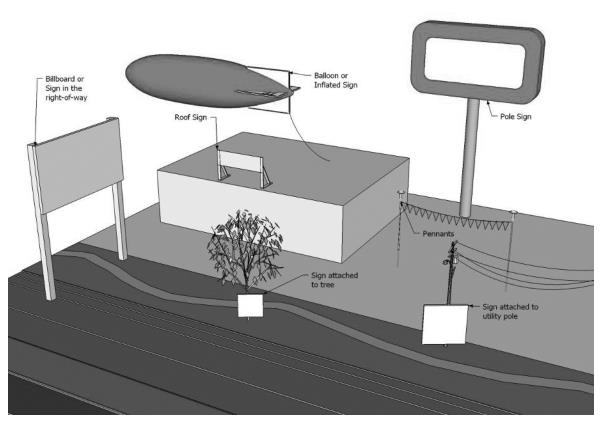
Note: Not all prohibited signs are shown.
[Ord. 1-2023 §3 (Exh. A), eff. 3-10-2023; Ord. 28-2007 §3, eff. 10-26-2007; Ord. 26-2006 §3, eff. 8-11-2006]
23.62.110 Standards for special category signs.
A. Awning and Canopy Signs. Awning and canopy signs may be permitted only as an integral part of the awning or canopy to which they are attached or applied, as follows:
1. Location. Signs may be placed only on awnings that are located on first- and second-story building frontages, including those fronting a parking lot or pedestrian way.
2. Maximum Area and Height. Sign area shall comply with the requirements established by Table 23.62-2 and EGMC Section 23.62.120, General development, maintenance, and removal. Sign area shall be calculated so as to only include the copy area. Copy area shall occupy a maximum of seventy-five (75%) percent of the awning face. No structural elements of an awning or canopy shall be located less than eight (8' 0") feet above the finished grade.
3. Illumination. Awnings shall not be illuminated from under the awning (back-lit) so that the awning appears internally illuminated. Lighting directed downwards that does not illuminate the awning is allowed.
4. Required Maintenance. Awning and canopy signs shall be regularly cleaned and kept free of dust and visible defects.
5. The style of the awning/canopy shall complement the architectural style of the building to which it is attached. Awnings shall have a simple horizontal valance if located over rectangular or square window/door openings. Domed or barrel shaped awnings shall be allowed for buildings with arched window/door openings.
B. Blade/Bracket Signs.
1. Location. Blade or bracket signs shall be placed only on ground floor facade, except for businesses located above the ground level with direct exterior pedestrian access.
2. Maximum Area, Height, and Projection. The maximum sign area shall be four (4 ft2) square feet. The lowest point of a blade or bracket sign shall be a minimum eight (8' 0") feet above grade. The sign may project a maximum of five (5' 0") feet from the building.
3. Sign Structure. Sign supports and brackets shall be compatible with the design and scale of the sign.
4. Encroachment. Any blade or bracket sign which encroaches into the public right-of-way, or above it, or into City-owned property, is subject to an encroachment permit.
C. Menu/Order Board Sign.
1. Location. Menu/order board signs shall not face onto the public right-of-way.
2. Illumination. Menu/order board signs shall only be illuminated by internal light source with opaque (nontransparent) background.
3. Maximum Size, Height, and Number. The size, height, and number of menu/order board signs shall be limited as described in EGMC Section 23.62.090(B)(9), Exempt signs, Menu/order board signs.
D. Freestanding Signs (Monument and Pylon).
1. Location. A freestanding sign may be located only along a site frontage adjoining a public street and not within the clear-vision triangle. It shall be set back a minimum of ten (10' 0") feet from the right-of-way. See EGMC Section 23.62.120, General development, maintenance, and removal.
2. Maximum Area and Height. The sign shall comply with the height and area requirements established in Table 23.62-2.
3. Design. The mass/scale of a freestanding sign shall be consistent with the overall design of the building. The design and placement of the sign shall not interfere with the required clear-vision triangle.
4. Landscape Requirements. Landscaping shall be provided at the base of the supporting structure equal to twice (2) the area of one (1) face of the sign. For example, twenty (20 ft2) square feet of sign area requires forty (40 ft2) square feet of landscaped area. The City may reduce or waive this requirement if the sign is placed within the required landscape corridor as required under EGMC Section 23.54.050(E), Landscape Corridors.
5. Construction. Freestanding signs may be constructed with poles as a substructure; provided, that the poles are covered with architectural cladding or coverings so they appear as a solid structure.
6. Materials and design for freestanding signs shall be complementary to the materials and design of the buildings for the related development. For example, if the facade of the building is made of brick or brick veneer, a complementary freestanding sign would also include brick.
E. Readerboard Signs. Readerboard signs are subject to:
1. Readerboards with manually changeable copy are allowed on parcels where the primary use is human assembly with the presentation of changing programs, such as theaters, museums, music concert facilities, churches, etc. The total area for these signs shall be included in maximum allowed sign area as listed in Table 23.62-2.
2. Electronic readerboard signs are permitted subject to the requirements of EGMC Section 23.62.100(E) and the requirements of EGMC Section 23.62.180, as applicable.
F. Time and/or Temperature Signs. A time and/or temperature sign does not count towards the otherwise applicable limits as to number and size, provided:
1. Maximum Area and Height. The sign shall have a maximum area of ten (10 ft2) square feet and shall comply with the height requirements established by Table 23.62-2.
2. Design. The sign shall be designed in a manner that is architecturally compatible with other signs and with the structure on which it is placed.
G. Building Signs. Where allowed in Table 23.62-2, a building sign shall comply with the following additional requirements:
1. Location. The sign shall not be placed to obstruct any portion of a window, doorway, transom, or other architectural detail.
2. Maximum Area and Height. The sign shall comply with the height and area requirements established in Table 23.62-2, and shall not project above the edge of a structure.
3. Projection from Wall. The sign shall not project from the surface upon which it is attached more than requirements for construction purposes and in no case more than twelve (12") inches. See EGMC Section 23.62.120, General development, maintenance, and removal, for three (3) dimensional elements on all signs.
4. Wall signs shall be compatible with the predominant visual architectural elements of the building facade.
5. Wall signs shall be placed to establish facade rhythm, scale, and proportion where such elements are weak. In many existing buildings that have a monolithic or plain facade, signs can establish or continue appropriate design rhythm, scale, and proportion.
6. Wall signs shall utilize a consistent proportion of signage to building scale. Examples include, but are not limited to, one-third (1/3) text to two-thirds (2/3) wall area or one-quarter (1/4) text to three-quarters (3/4) wall area. See Figure 23.62-2b (Text Scale).
Figure 23.62-2b
Text Scale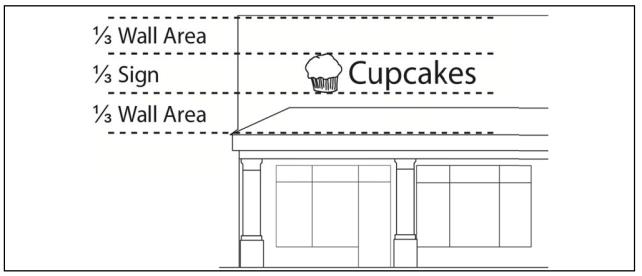
7. Wall sign raceways shall be concealed from public view (e.g., within the building wall or painted to match the exterior color of the building where the sign is located) or otherwise integrated with the design of the sign and building so as to not detract from the architectural character of the building.
8. Direct and indirect lighting methods are allowed for wall signs; provided, that they are not harsh or unnecessarily bright. Light shall either be directed down or in such a way that it does not cause light trespass or glare onto adjoining properties or public rights-of-way.
9. Can signs are discouraged. Channel letters, reverse channel letters, and push pin letters are preferred.
10. If a tenant’s signage on one facade is comprised of multiple elements (e.g., logo and text), the elements shall be located and scaled with relationship to each other. See Figure 23.62-2c (Multiple Element Signs).
Figure 23.62-2c
Multiple Element Signs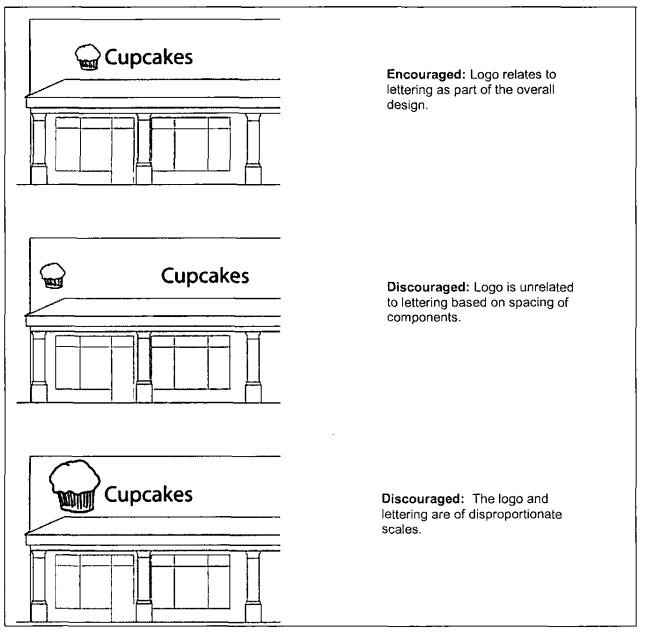
[Ord. 1-2023 §3 (Exh. A), eff. 3-10-2023; Ord. 28-2019 §3 (Exh. A), eff. 2-7-2020; Ord. 14-2017 §3 (Exh. C), eff. 6-23-2017; Ord. 13-2013 §6, eff. 10-25-2013; Ord. 8-2011 §29(E), eff. 6-24-2011]
23.62.120 General development, maintenance, and removal.
This section describes the standards applied to the development, maintenance, and removal of signs within the City.
A. Measurement of Sign Area.
1. The surface area of a sign shall be measured by enclosing each of the outermost limits of writing, representation, emblem, or any fixture of similar character, together with any frame or material or color forming an integral part of the display or used to differentiate such sign from the background against which it is placed (see Figure 23.62-3). If the sign (or a part of the sign that is enclosed by one rectangle that makes up the total sign) is composed of individual letters or symbols using the wall as the background with no added decoration (e.g., “channel letters”), the total sign area shall be calculated as seventy-five (75%) percent of the area of any rectilinear geometric figure that encloses the extreme limits of the characters or symbols.
Figure 23.62-3
Measurement of Sign Area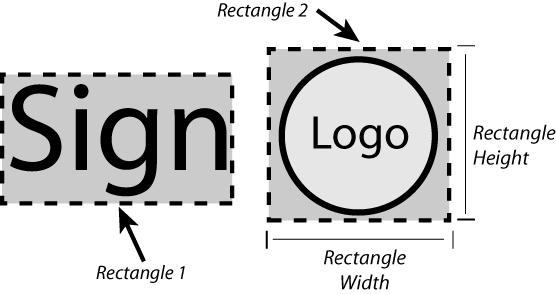
Sign area is calculated by drawing an imaginary box around all writing and figures with a maximum of five (5) simple rectangles and calculating the area of each rectangle using standard mathematical formulas, then (when the sign is composed of channel letters) taking seventy-five (75%) percent of that calculation (e.g., seventy-five (75%) percent x (height x width) = sign area).
2. Supporting framework or bracing that is clearly incidental to the display itself shall not be computed as sign area;
3. Signs composed of more than one sign face shall be computed as including only the maximum single display surface that is visible from any ground position at one time;
4. Where a sign consists of one (1) or more three (3) dimensional objects (e.g., balls, cubes, clusters of objects, sculpture, or statue-like trademarks), the sign area shall be measured as their maximum projection upon a vertical plane, as viewed from a position in the public right-of-way which produces the largest visual projection;
5. For signs that incorporate time and temperature devices, the area of these devices shall not be included in the total area of the sign; however, when time and temperature are combined with a commercial message or image, on the same visual plane, then the time and temperature indicators are included within the sign area;
6. Primary Building Frontage. Where the maximum allowed sign area is based upon the measurement of a building’s primary frontage, the primary frontage shall be the building frontage facing the street. In cases where a building has more than one (1) street frontage, the longest of the street frontages shall be considered the primary building frontage. In cases where a business has no building frontage facing a street, the building frontage with the primary business entrance shall be considered the primary building frontage. A single multi-tenant building has one primary frontage, the allowable sign area for which may be distributed at the discretion of the owner; however, in no event shall the combined sign area for all tenants exceed the allowable sign area for the building (see Figure 23.62-4);
Figure 23.62-4
Sign Area and Distribution by Primary Building Frontage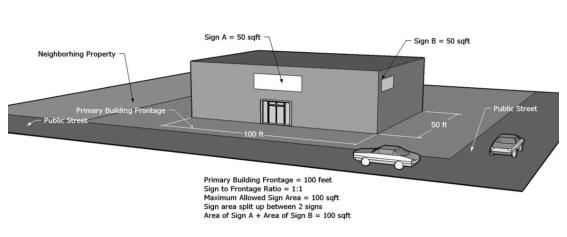
B. Measurement of Sign Height. Sign height shall be measured from the uppermost part of the sign used in determining the area of the sign to the lowest elevation at the base of the sign.
C. Maintenance of Signs. All signs shall comply with the following criteria:
1. All transformers, equipment, programmers, and other related items shall be screened and/or painted to match the building or shall be concealed within the sign;
2. All permanent signs shall be constructed of quality, low-maintenance materials such as metal, concrete, natural stone, glass, and acrylics. Techniques shall be incorporated during construction to reduce fading and damage caused by exposure to sunlight or degradation due to other elements;
3. All signs shall be constructed in compliance with any applicable building, electrical, or other code in effect at the time of construction or maintenance, with particular respect to wind and seismic loads and overturning moment;
4. All freestanding signs that incorporate lighting shall have underground utility service;
5. Signs shall be cleaned, updated, and/or repaired as necessary to maintain an attractive appearance and to ensure safe operation of the sign. Unacceptable sign conditions include: broken or missing sign faces, broken or missing letters, chipped or peeling paint, water damage, missing or inoperative lights, exposed mechanical or electrical components, and missing or broken fasteners. Failure to respond to a written request from the City to perform maintenance work shall result in revocation of the sign’s permit or status as exempt from permit, subject to the appeal provisions stated in EGMC Section 23.62.080;
6. All temporary signs and banners shall be made of a material designed to maintain an attractive appearance for as long as the sign is displayed;
7. All illuminated signs shall be of such intensity or arranged in such a manner so as to avoid unreasonable glare for abutting properties or vehicular traffic.
D. Illumination Standards. The artificial illumination of signs, either from an internal or external source, shall be designed to minimize negative impacts on surrounding rights-of-way and properties. The following standards shall apply to all illuminated signs:
1. External light sources shall be directed and shielded to limit direct illumination of an object other than the sign;
2. The light from an illuminated sign shall not be of an intensity or brightness that will create glare or other negative impact on residential properties in direct line of sight to the sign;
3. Unless otherwise permitted by another provision of this chapter, signs shall not have blinking, flashing, or fluttering lights, or other illumination devices that have a changing light intensity, brightness, or color;
4. Colored lights shall not be used at a location or in a manner so as to be confused or constructed as traffic control devices;
5. Reflective-type bulbs and incandescent lamps that exceed fifteen (15) watts shall not be used on the exterior surface of signs so that the face of the bulb or lamp is exposed to a public right-of-way or adjacent property; and
6. Light sources shall utilize energy-efficient fixtures to the greatest extent possible.
E. Sign Removal or Replacement. When a sign is removed or replaced, all brackets, poles, and other structural elements that support the sign shall also be removed. Affected building surfaces shall be restored to match the adjacent portion of the structure. This provision does not apply to routine maintenance.
F. Setback of Freestanding Signs (Permanent and Temporary). The minimum setback distance for signs shall be measured from back of the public right-of-way, unless an encroachment permit is granted. All freestanding signs shall be set back a minimum of ten (10' 0") feet from the public right-of-way with the following exception:
1. Where the public right-of-way has not been improved to its ultimate width, signs shall be set back from the ultimate right-of-way as defined by the Public Works Department. Until such time as the right-of-way is improved to its ultimate width, the applicant may be granted an encroachment permit to allow the sign to be placed within the ultimate right-of-way; provided, that when the right-of-way is improved the owner of the sign shall be required to remove or otherwise relocate the sign (at their own cost) and shall be subject to the current standards as provided in this title. All encroachment permits for signs may be revoked by the City with thirty (30) days’ written notice.
G. Location of Building Signs. Building signs may be located along any public frontage, which includes that area of a building that faces directly onto a public right-of-way, an internal circulation path of the site, or a parking lot. In no case shall signs face directly onto residential property. A building may have multiple public frontages, as shown in Figure 23.62-5. Orientation of signs such that they face directly onto residential property is to be avoided, and allowed only when there is no practical alternative, and the visibility of the sign from the residence is minimized.
Figure 23.62-5
Allowed Locations for Building Signs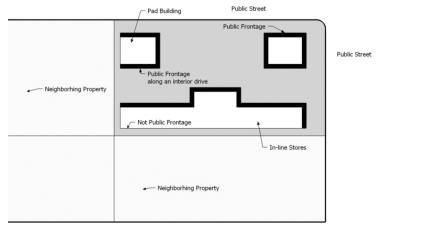
[Ord. 14-2017 §3 (Exh. C), eff. 6-23-2017; Ord. 8-2011 §29(F), eff. 6-24-2011; Ord. 28-2007 §3, eff. 10-26-2007; Ord. 26-2006 §3, eff. 8-11-2006]
23.62.130 Permitted signs by type and development characteristics.
Signs permitted within the City are regulated by sign and corresponding development type and/or zoning district. The standards for their development are described in Table 23.62-2 below. Zoning clearance (administrative plan check) is required to determine compliance with applicable provisions of this chapter. Only those signs that may be permitted are listed. The goal of these standards is to regulate permanent signs that have a commercial message so that they comply with the purpose of this chapter, as established in EGMC Section 23.62.010, Purpose and applicability. Noncommercial signs and signs that are exempt from these standards are described in EGMC Section 23.62.090, Exempt signs. Temporary signs are listed in EGMC Section 23.62.140, Temporary and special event signs. New billboards authorized pursuant to an agreement to relocate existing billboards are governed by EGMC Section 23.62.180. The following general standards apply to permanent signs regulated in this section:
A. Sign Types. The following signs are applicable to this section:
1. Building signs are those signs that are permanently attached to a building (e.g., wall signs, blade/bracket signs, etc. (see Figure 23.62-6));
2. Freestanding signs are those that have their own unique foundation or are otherwise not attached to a building (e.g., monument sign shown in Figure 23.62-7);
B. Maximum Sign Area. The total allowed sign area is identified in Table 23.62-2 with the following requirements.
1. The total allowed sign area may be distributed among the maximum number of signs permitted for each sign type. See Figure 23.62-4 for an example.
2. Allowable sign area is either a set square footage per business or is based on a ratio of sign area to primary building frontage. It is calculated as described in EGMC Section 23.62.120, General development, maintenance, and removal. Where a ratio is described, it applies up to the listed maximum sign area. See Figure 23.62-4.
C. Public frontage is that area of the building that faces onto a public right-of-way, an internal circulation aisle, or a parking lot. In no case shall signs face directly onto residential property. (See EGMC Section 23.62.070 and Figure 23.62-5.)
D. Illumination standards refer to whether or not the sign may be illuminated and how. Signs may be illuminated through an “indirect or background” light source (an indirect light source is a low-wattage spotlight glare to the adjoining property, or internal light source with opaque, nontransparent background), or by any method that minimizes glare onto adjoining residential property.
|
Sign Type |
Maximum Number Permitted |
Maximum Area |
Maximum Height |
Minimum Setback from ROW |
Illumination Standards |
Other Standards (See Notes) |
|---|---|---|---|---|---|---|
|
Residential Dwellings/Uses |
||||||
|
1. Building signs1 |
1/home |
2 sf. |
Roofline |
– |
No illumination |
2 |
|
Single-Family Subdivisions |
||||||
|
1. Freestanding signs: entry monument |
1/project entrance3 |
24 sf. each3 |
6 ft. |
10 ft. |
Indirect or background |
|
|
Multifamily Dwellings and Complexes |
||||||
|
1. Building signs |
1/complex |
6 sf. |
Roofline |
– |
No illumination |
4 |
|
2. Freestanding signs |
1/vehicle entrance |
25 sf. each |
6 ft. |
10 ft. |
Indirect or background |
4 |
|
Agricultural Uses |
||||||
|
1. Building signs |
1/ establishment |
20 sf. each |
6 ft. |
– |
No illumination |
|
|
2. Freestanding signs |
1/ establishment |
20 sf. each |
8 ft. |
10 ft. |
No illumination |
|
|
Permitted Nonresidential Uses in Agricultural and Residential Zoning Districts |
||||||
|
1. Building signs |
1/ establishment |
20 sf. |
Roofline |
– |
No illumination |
2 |
|
2. Freestanding signs |
1/ establishment |
20 sf. |
10 ft. |
10 ft. |
No illumination |
|
|
Commercial Zoning Districts |
||||||
|
1. Building signs: pad buildings and in-line stores > 50k sf. |
1/public frontage6 |
2.5:1 with max 250 sf. total for all signs7 |
Roofline |
– |
5 |
2 |
|
2. Building signs: in-line stores < 50k sf. |
1/public frontage6 |
2:1 with max 200 sf. total for all signs |
Roofline |
– |
5 |
2 |
|
3. Freestanding signs: individual establishments |
1/project entrance |
50 sf. |
10 ft. |
10 ft. |
Indirect or background |
|
|
4. Freestanding signs: integrated development |
1/project entrance |
150 sf./sign |
20 ft. |
10 ft. |
Indirect or background |
|
|
Office and Industrial Zoning Districts |
||||||
|
1. Building signs |
1/public frontage6 |
1:1 with max 150 sf. |
Roofline |
– |
5 |
|
|
2. Freestanding signs, standalone project |
1/ establishment |
25 sf. |
10 ft. |
10 ft. |
5 |
|
|
3. Freestanding signs, integrated development |
1/project entrance |
50 sf./sign |
10 ft. |
10 ft. |
5 |
|
|
Permitted Uses in the Open Space Zoning District |
||||||
|
1. Building signs |
1/ establishment |
20 sf. |
6 ft. |
– |
No illumination |
|
|
2. Freestanding signs |
1/ establishment |
16 sf. |
10 ft. |
10 ft. |
5 |
|
Notes:
1. Excludes name plates as described in EGMC Section 23.62.090; see Figure 23.62-6 for illustrations of allowed building signs and Figure 23.62-7 for illustrations of allowed freestanding signs.
2. Must be attached to the main building on the front of the building.
3. Sign area may be distributed on up to two (2) signs at any one (1) intersection with combined square footage not to exceed total.
4. Excludes on-site directional signs or name plates as described in EGMC Chapter 23.100.
5. Minimize glare onto residential property.
6. Additional signs for each public frontage are allowed as long as the cumulative sign area does not exceed the maximum square footage allowed, as identified in Table 23.62-2 above, and calculated pursuant to Sections 23.62.110(G) and 23.62.120(A)(1).
7. Buildings over seventy-five thousand (75,000 ft2) square feet may exceed the maximum signage total through a major design review approval issued pursuant to EGMC Chapter 23.16.
Figure 23.62-6
Permitted Building Sign Types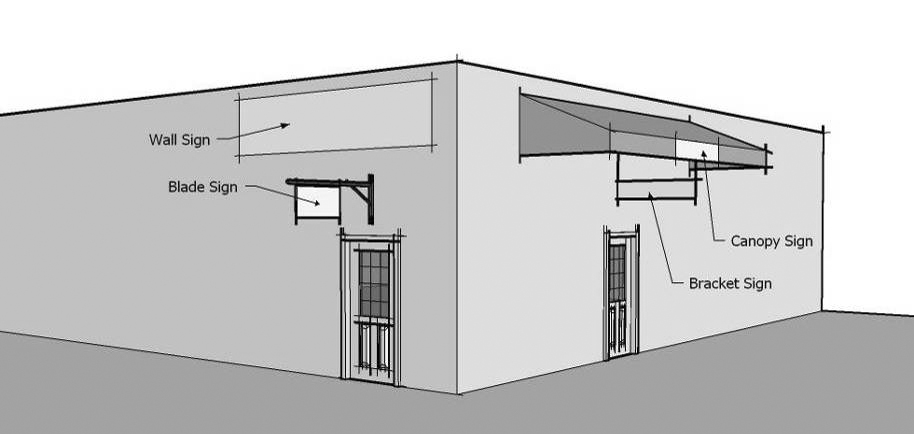
Note: See EGMC Section 23.62.120 and Table 23.62-2 for development standards for these types of signs.
Figure 23.62-7
Freestanding Sign Types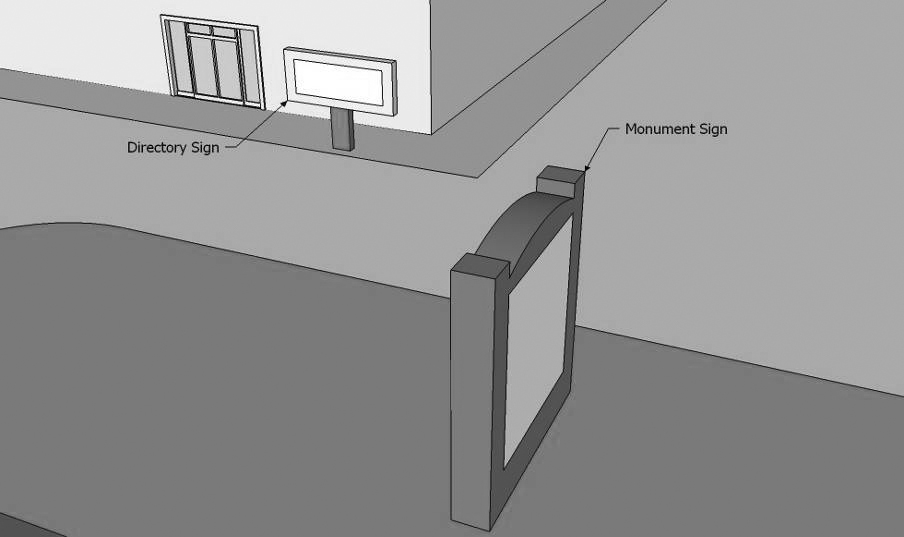
Note: See EGMC Section 23.62.120 and Table 23.62-2 for development standards for these types of signs.
[Ord. 1-2023 §3 (Exh. A), eff. 3-10-2023; Ord. 14-2017 §3 (Exh. C), eff. 6-23-2017; Ord. 24-2015 §11 (Exh. I), eff. 2-12-2016; Ord. 12-2012 §10(A), eff. 7-27-2012; Ord. 8-2011 §29(G), eff. 6-24-2011]
23.62.140 Temporary and special event signs.
This section describes standards for temporary signs, special event signs, and signs for subdivisions.
A. Temporary Signs. Temporary commercial signs for grand openings, special product, sale, or event advertising are allowed within the City with the development standards described below. While the City does not issue temporary sign permits, provisions herein will be enforced pursuant to this chapter and other appropriate City law.
1. Time Duration. Each establishment may display a maximum of two (2) weeks temporary promotional signs per calendar quarter or season, not to exceed a total of eight (8) weeks per calendar year. Temporary advertising periods may be combined, but may never be longer than four (4) consecutive weeks (thirty (30) consecutive days) at any one (1) time.
2. Illumination. No temporary signs may be illuminated.
3. Table 23.62-3 describes the development standards with regards to maximum number, area, height, and setback from the public right-of-way. In no case may a temporary sign be placed within a required clear-vision triangle.
|
Use Type |
Maximum Temporary Number Permitted |
Maximum Area |
Maximum Height |
Minimum Setback from ROW |
|---|---|---|---|---|
|
Commercial uses, building signs |
1/establishment |
36 sf. each |
Roofline |
– |
|
Commercial uses, freestanding signs |
1/establishment |
6 sf. |
5 ft. |
10 ft. |
|
Auto dealerships |
3/establishment |
36 sf. each |
10 ft. |
10 ft. |
|
Office and industrial uses |
3/establishment |
10 sf. each |
10 ft. |
10 ft. |
|
Permitted uses in the open space zoning district |
1/establishment |
10 sf. |
8 ft. |
10 ft. |
|
Noncommercial and public/quasi-public uses |
2/use |
5 sf. total |
5 ft. |
10 ft. |
|
Temporary window signs |
N/A |
25% of total window area |
N/A |
N/A |
Figure 23.62-8
Temporary Sign Types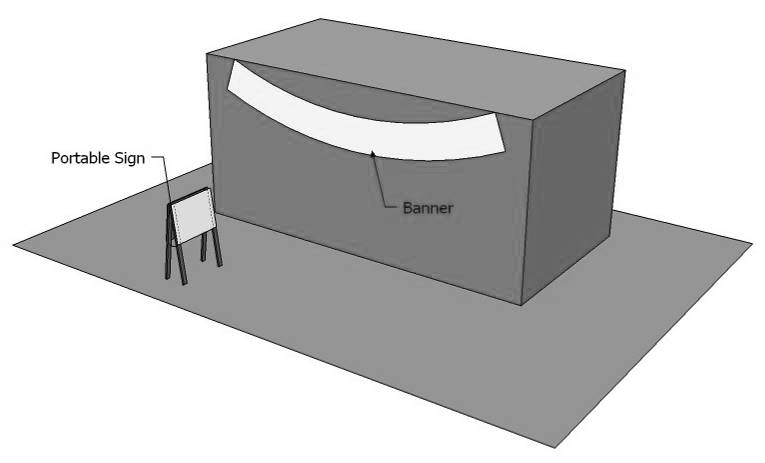
Notes: See EGMC Section 23.62.140 for development standards for these types of signs; not all allowed permitted temporary signs are shown.
B. Special Event Signs. Signs not otherwise permitted in this chapter (e.g., beacons, pennants, freestanding banners, inflatable signs), are not regulated by this chapter, but instead by public assembly, parades, and street closures provisions not adopted as part of this title.
C. Subdivision Signs. Temporary and limited-term subdivision signs for both on-site identification and off-site directional signs are allowed in accordance with the following standards. Single-family subdivision sign provisions shall apply to integrated developments only and not to any single residential lot.
1. On-Site Signs. On-site directional/identification signs shall be permitted in accordance with the provisions listed in Table 23.62-4. (Also see permanent subdivision identification signs in Table 23.62-2, exempt real estate signs in EGMC Section 23.62.090(B)(13), and exempt flags in EGMC Section 23.62.090(B)(4) and Table 23.62-4.)
2. Off-Site Signs. Off-site directional signs may be posted on private land only, through either co-located directory kiosks or weekend directional signs (for a limited period) as described below:
a. Joint Use Kiosks. Directional kiosks provide co-location opportunities for direction and identification of multiple projects on joint use structures. Such signs shall be subject to the development standards as described in Table 23.64-3 and as follows:
i. No off-site sign shall have any tag signs, streamers, balloons, devices, display boards, or appurtenances added to the sign for the purpose of attracting attention as originally approved.
ii. Each kiosk may have up to eight (8) individual subdivision nameplates on each side providing identification and direction to subdivision location.
iii. Each kiosk may have a maximum of four (4) sides/faces; provided, that each face is oriented so that only one (1) face/side is clearly visible to each direction of vehicular travel.
iv. The design of the joint use kiosk is flexible. Figure 23.62-9 illustrates a design consistent with the standards listed herein. However, the City encourages the use of a consistent design that incorporates the City logo and identifies the projects listed on the kiosk as new homes for sale in the City. The City may establish a preferred joint use kiosk design that kiosk applicants may elect to use.
b. Weekend Directional Signs. For the interim period of five (5) months from the effective date of this section, subdivisions may display temporary weekend directional signage in accordance with Table 23.62-3 and the standards below.
i. Weekend directional signs are prohibited on publicly owned land.
ii. Weekend directional signs may not be erected before noon on Friday and must be removed no later than noon the following Monday. In the event that Friday is a nationally recognized holiday, the weekend directional signs may be erected on Thursday after noon. In the event that Monday is a nationally recognized holiday, the weekend directional signs may remain in place until Tuesday by noon.
3. Standards Applicable to All Subdivision Signs.
a. Sign Removal. Signs are to be permanently removed when the last home in the subdivision is sold or the sign permit expires, whichever occurs first.
|
Sign Type |
Maximum Temporary Number Permitted |
Maximum Area |
Maximum Height |
Minimum Setback from ROW |
Illumination Standards |
Other Standards (See Notes) |
|---|---|---|---|---|---|---|
|
1. On-site (freestanding) |
1/project entrance, max. 6 |
32 sf. each |
10 ft. |
5 ft. |
No Illumination |
|
|
2. Off-site joint use kiosk (freestanding) |
1/major intersection1 |
100 sf per sign face on kiosk |
18 ft. |
10 ft. |
No Illumination |
2 |
|
3. Individual project nameplate (on joint use kiosk) |
8/kiosk face; 6 nameplates/ project throughout City |
12.5 sf. each |
n/a |
n/a |
No Illumination |
3 |
|
4. Off-site weekend directional signs4 |
25/project 5/block |
4 sf. each |
4 ft. |
5 ft. |
No Illumination |
|
Notes:
1. A major intersection is defined as the intersection of two (2) or more arterial or collector roads, as defined in Figure CI-2, Master Plan of Roadways, of the General Plan.
2. Only one (1) off-site freestanding kiosk sign is permitted at each major intersection within the City.
3. Must be co-located with other projects on directional kiosks.
4. Only as an interim to the creation of freestanding kiosk signs as described by EGMC Section 23.62.140(C)(2)(a).
Figure 23.62-9
Example Off-Site Directional Kiosk Sign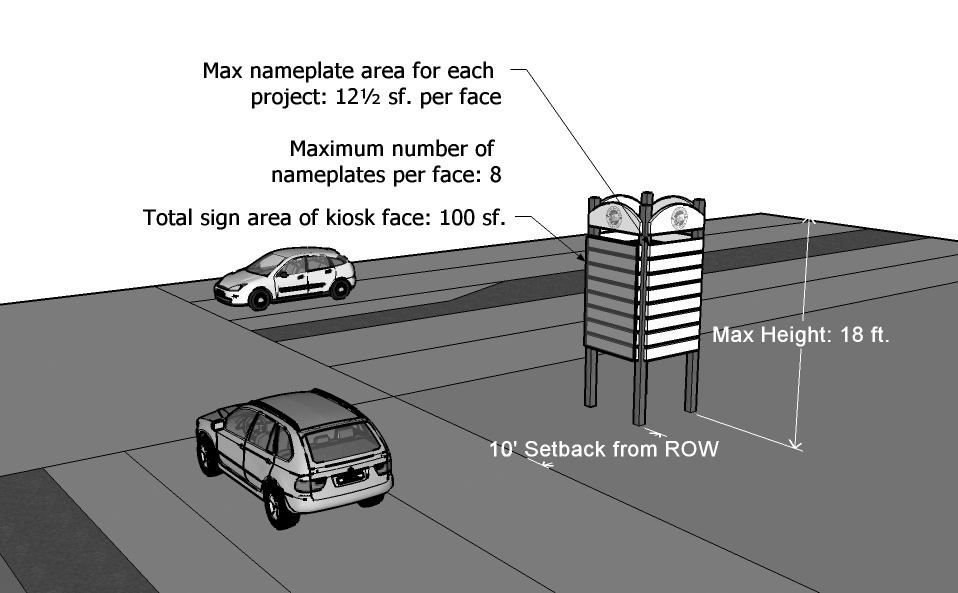
[Ord. 24-2015 §11 (Exh. I), eff. 2-12-2016; Ord. 27-2013 §12, eff. 2-7-2014; Ord. 8-2011 §§29(H), (I), eff. 6-24-2011; Ord. 28-2007 §3, eff. 10-26-2007; Ord. 26-2006 §3, eff. 8-11-2006]
23.62.150 Signs on residential uses.
Residential uses (other than home occupations as regulated in EGMC Section 23.62.130) may display signs subject to the requirements of this section. For each dwelling unit, signs may be displayed as stated in Table 23.62-5 and as listed below, without permits. The following rules do not apply to flags or to signs identifying the address and/or occupants. Such signs may display noncommercial messages conveying garage sales, yard sales, etc.
A. Signs with Two (2) Faces. Only one (1) side of a two (2) faced sign shall be counted in the calculation of sign area.
B. Noncommercial Message Signs. During the time period beginning sixty (60) days before a special, general or primary election, and ending seven (7) days after such election, the total allowed sign area may be increased by an additional five (5 ft2) square feet over the maximum sign area listed in Table 23.62-5.
C. Illumination. Illumination of signs is prohibited.
|
Sign Type |
Maximum Number |
Maximum Total Area, All Signs1 |
Maximum Height |
Minimum Setback from ROW |
|---|---|---|---|---|
|
Single-Family Residential Districts and Uses |
||||
|
A-frame signs |
1 |
8 sf. |
4 ft.2 |
5 ft.3 |
|
All others |
Not limited |
5 sf. |
Roofline of dwelling |
5 ft.3 |
|
Multifamily Residential Districts and Uses4 |
||||
|
All sign types5 |
Not limited |
5 sf. |
Roofline of dwelling |
5 ft.3 |
Notes:
1. Maximum sign area does not include flags or signs indicating the address and/or residents or home occupation.
2. Maximum width is thirty (30") inches.
3. May not be located within any required clear-vision triangle.
4. Includes multifamily residential units and mobile home parks, but not including units in transient occupancy facilities (hotels, motels, etc.). Standards listed are per dwelling unit.
5. Freestanding yard signs or signs on fences require the consent of the landowner.
[Ord. 26-2006 §3, eff. 8-11-2006]
23.62.160 Nonconforming signs.
Signs that were legally established prior to the adoption, or subsequent amendments, of this chapter, but are inconsistent with the adopted content are considered legal nonconforming uses, and are “grandfathered” by this chapter. As such, they may continue to exist; provided, that they are not altered, modified, or changed in any way that would increase their nonconformity. When such modification-alteration-change occurs or is proposed (as defined in EGMC Chapter 23.84, Nonconforming Uses, Buildings, Structures), the sign shall be brought into compliance with this chapter, requiring zoning clearance, and the clearance shall be reviewed under the specifications of EGMC Section 23.62.070. [Ord. 26-2006 §3, eff. 8-11-2006]
23.62.170 Abandoned signs.
As of the date of first adoption of this chapter, no legally established signs shall be considered abandoned. For regulatory purposes, any factors indicating abandonment shall not begin accruing until ninety (90) days after the effective date of this chapter. [Ord. 8-2011 §29(J), eff. 6-24-2011]
23.62.180 Relocated billboards.
A. The requirements of this section shall apply to any project involving the relocation of a billboard in existence on the effective date of the ordinance codified herein. Such relocated billboards shall only be installed, constructed, or relocated in commercial, office, or industrial zoning districts as defined by this title. Relocated billboards shall not be located in the rural commercial combining zone or the Elk Grove triangle special planning area.
B. The installation or construction of a relocated billboard pursuant to this section may only occur after City Council approval of a relocation agreement among the billboard operator, relevant property owner(s), and the City, and City approval of a sign permit for the billboard (see EGMC Sections 23.16.020 and 23.62.070(A)).
C. All agreements governing the relocation of billboards shall include requirements that applicants adhere to all applicable Federal and State laws. Nothing contained in this chapter shall require the City approve a relocation agreement on terms that are unacceptable to the City Council, including those agreements that do not comply with Federal or State law.
D. New billboards authorized pursuant to an agreement to relocate presently existing, legal billboards shall be governed by the development, maintenance, and removal standards provided in the relocation agreement. In the event of any conflict between any provision contained in an agreement subject to this section and any other provisions contained elsewhere in this chapter, the provisions of the applicable relocation agreement shall govern. [Ord. 1-2023 §3 (Exh. A), eff. 3-10-2023]


